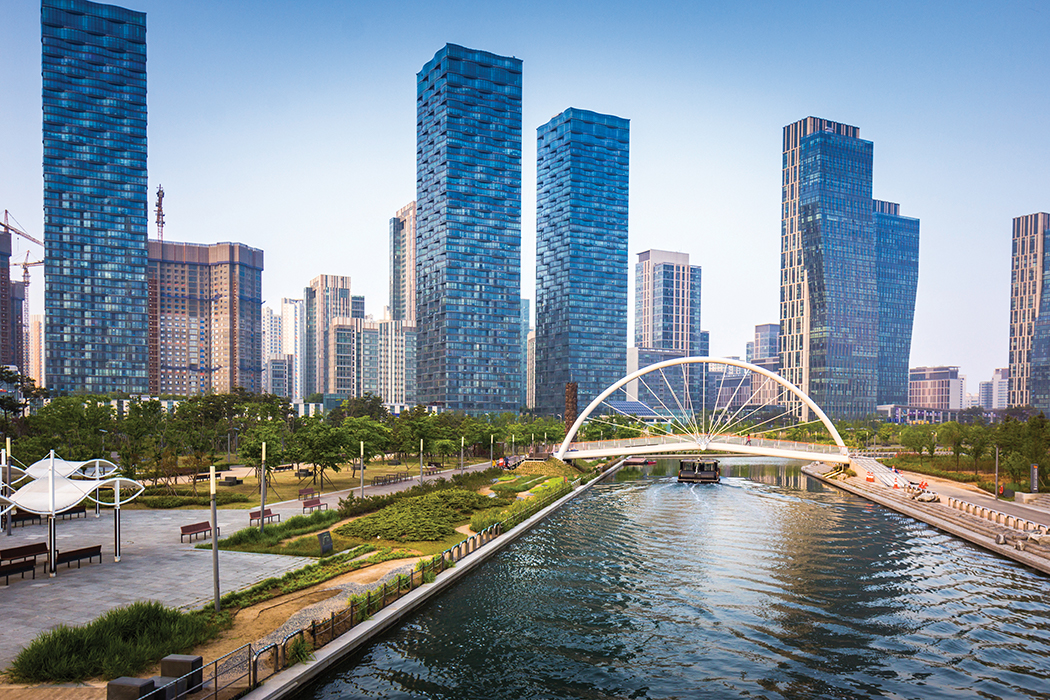As Technology Evolves, Smart(er) Cities Becoming a Reality
It has been nearly two decades since the concept of the smart city first garnered media attention, blazing the trail for a movement that continues to gain traction, albeit in ways that are still evolving.
Songdo, located approximately 20 miles south of Seoul, South Korea, was built from the ground up on 1,500 acres of reclaimed land, and envisioned by developer Gale International to be a prototype for future cities—green, sustainable, and employing state-of-the-art technologies to provide an enhanced quality of life for its residents.
Now nearing completion, Songdo has fallen short of its promise in many ways, but the vision it sparked has inspired city planners around the globe to seek ways to leverage technology to create more energy efficient, sustainable, and livable environments for their citizenry.
While the term “smart city” has no universally accepted definition, Michael Zeto III, general manager for AT&T's Smart Cities business unit, describes smart city initiatives as “the use of technology in a really strategic way that will drive public safety, efficiencies, sustainability initiatives, and improve the overall livability for its citizens.”
With 55% of the world’s population currently living in urban areas—a number expected to balloon to 68% by 2050 according to estimates by the United Nations—seeking smart city solutions is becoming more of a necessity than a utopian dream.

Songdo Central Park, South Korea“Urbanization is exploding globally as technology and social change are making cities more attractive to people and companies,” says Dennis Frenchman, director of the MIT Center for Real Estate. “Now we’re seeing existing cities—many designed using 20th century models—failing to perform at many levels, from transport to health care, while government is losing the resources, talent, and the will to re-invent and redevelop cites. It’s clear that we need a new approach.”
Much of that new approach is being driven by a new generation of digital natives—millennials and younger people—particularly in developed countries like the United States. Millennials constitute the largest generational cohort ever, pioneering a digital lifestyle where everything is increasingly connected, Frenchman notes. Smart phones, wearable computing, and internet of things (IoT) devices, financial transactions, commercial security systems, and smart city technologies, as well as Alexa and Siri, are now capable of tracking where people travel, what they purchase, what they eat and who they meet, as well as everything from vital signs to emotional states.
Seeking smart city solutions is becoming more of a necessity than a utopian dream.
“And there is a byproduct of all these sensors—huge streams of data that for the first time, are showing us how cities actually function, and they are not functioning well,” said Frenchman. He adds that the data is also opening up new opportunities to address these problems, resulting in ever more rapidly emerging urban technologies. “There is a systemic transformation underway from the bottom up that will reshape urban form and function, governance, and processes of development, and it is a far cry from the early ‘smart city’ ideas of 20 years ago,” he concludes.
While there are developments like Digital Media City in Seoul (a South Korean project constructed on 141 acres in 2006) that more fully realize what digital cities can become, the reality is that many smart city initiatives are limited to leveraging existing technologies like cell phones and sensors, incremental technological upgrades to city systems, or the creation of smart city “innovation” districts within larger cities or college/corporate campuses.
“There are people who think of [smart cities] as having this kind of global dashboard, where you can walk into City Hall and have this Death Star-like command center that’s got everything that’s going on in the city, and that’s just not realistic right now,” says Ken Hosac, vice president of IoT strategy and business development for network solutions provider Cradlepoint, Inc. When working with municipalities, Hosac encourages them to find success by going for “base hits rather than home runs,” which means finding one or two prioritized projects that can help deliver a more capable, economical, and productive city.
His firm has created digital solutions for traffic management in the City of San Antonio that allows traffic managers to investigate problems at intersections remotely via livestream; established live video links between EMS workers and specialists at the University of Virginia emergency room to improve outcomes for stroke victims; and devised a system that allows multiple police officers to converge onto an incident scene and access the secure police network via mobile hotspots. The technology helps to save time and operational expenses, boost efficiencies, and reduce errors—often using funds from the municipalities’ IT budgets.

A 2018 McKinsey Global Institute report, “Smart Cities: Digital Solutions for a Livable Future” analyzed dozens of current smart city applications and found that cities that deploy them could reduce fatalities by 8–10%, accelerate emergency response times by 20–35%, shave the average commute by 15–20%, and cut greenhouse gas emissions by 10–15%, among other positive outcomes.
“It’s mostly about coordination and efficiency of resources,” says real estate attorney Louis Archambault, partner at Saul Ewing Arnstein & Lehr, LLP, who lectures frequently on smart cities, IOT technology, big data analytics, and blockchain. “The essence of a smart building or city is its ability to communicate quickly and in real time with whatever building or service we’re talking about—mobility, security, healthcare, or public service (EMS, first responders).”
Archambault cites the case of a smart building with a fire emergency. With sensors in place and a communications network coordinated with the city, the fire department can access building systems data to determine the location and intensity of the fire based on temperature readings, as well as where building occupants are located. First responders can quickly perform an on-scene evaluation and deploy resources, bolstered by real-time alerts showing conditions within the building, thus saving lives, improving firefighter safety, and reducing property losses. “What it comes down to is, ‘How do we efficiently use our resources, and how do we use the data for the public interest?’” says Archambault.

Dallas, TexasCreating a smarter city is much more than just installing sensors and network systems, however. According to the Dallas Innovation Alliance (DIA), a coordinated and engaged community is a key element to creating a smart and inclusive city. Launched as a public-private partnership in 2015, DIA is a coalition of three dozen corporate, public, non-profit, and academic organizations—along with 20 City of Dallas departments—working with more than 100 community organizations to engage residents.
In 2017, the DIA created a smart cities “Living Lab” in the four-block Dallas Innovation District in historic West End. Using a holistic approach, DIA put a focus on five key use cases: energy and water efficiency, neighborhood revitalization, public health and safety, citizen engagement, and parking and transportation. “What it ultimately boiled down to was improving quality of life and solving challenges that impact economic development and resource efficiency,” says DIA executive director Jennifer Sanders, who co-founded the organization along with entrepreneur Trey Bowles. “These ‘smart’ solutions are enabled by utilizing tools that haven’t existed until recent times—like the use of data and technology—while working alongside a community.”
Phase one of the Living Lab’s digital infrastructure initiatives included installing smart LED lighting, environmental sensors, smart parking, water, and irrigation solutions, as well as public Wi-Fi and an interactive informational kiosk—leading to significant cost and energy savings that can be replicated throughout the city. The Living Lab helped to energize the Innovation District, bringing an influx of tech companies responding to redevelopment efforts of historic buildings by institutional real estate investors, who saw the potential of the neighborhood as a tech hub and embraced the smart city initiatives.
In Boston, the HYM Investment Group, LLC will soon break ground on a 161 acre site—formerly home to horse racing track Suffolk Downs—that will deliver 16 million square feet of mixed-use development, including 10,000 units of housing, five million square feet of office/lab space, “neighborhood” retail and hotels. Thomas N. O’Brien, managing director and founding partner of HYM, says the primary objective is to build a true community “and the size of the site gives us a great chance to implement a lot of the most interesting aspects of the smart city movement.”
Suffolk Downs will emphasize connectivity, energy reduction, and—most important—the creation of a sustainable, livable environment. O’Brien says there will be clear connectivity across all building types, which will allow the project to achieve specific energy reduction goals as well as enhance community connections, similar to what is offered by many luxury multifamily or office tenant experience apps—and there will be free Wi-Fi throughout the development.
The entire site will be constructed to be micro-grid ready, and every building will be constructed to be solar-ready—although the design team anticipates enhancements to current energy and networking systems, so no specifics have been finalized. However, HYM has committed to creating two megawatts of electricity across the entire site, utilizing emerging solar technologies. HYM will be constructing all the streets, water, sewer, and utilities, “so there’s a great opportunity to create a utility system that is really forward thinking and highly efficient,” says O’Brien.
But it is not just the technological enhancements that make a city “smart.” HYM has committed one quarter of the site—40 acres—to open space, and plans reflect a commitment to climate change mitigation strategies for the project. Building community is a cornerstone of the project, so HYM has committed to designing an extension of the East Boston Greenway to create an improved biking, running, and walking experience, and formed a partnership with the East Boston Social Centers to create a more interconnected, community-oriented neighborhood.
“We’re trying to do things differently,” says O’Brien, “in a way that hopefully creates real communities for people.”
Which is the ultimate goal of all smart cities.
CONTRIBUTING MEMBERS
Louis Archambault